
An outboard motor is a propulsion system for boats, consisting of a self-contained unit that includes engine, gearbox and propeller or jet drive, designed to be affixed to the outside of the transom. They are the most common motorised method of propelling small watercraft. As well as providing propulsion, outboards provide steering control, as they are designed to pivot over their mountings and thus control the direction of thrust. The skeg also acts as a rudder when the engine is not running. Unlike inboard motors, outboard motors can be easily removed for storage or repairs.
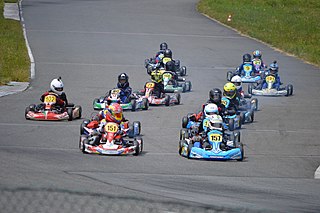
Kart racing or karting is a motorsport discipline using open-wheel, four-wheeled vehicles known as go-karts or shifter karts. They are usually raced on scaled-down circuits, although some professional kart races are also held on full-size motorsport circuits. Karting is commonly perceived as the stepping stone to the higher ranks of motorsports, with most Formula One drivers—including Ayrton Senna, Michael Schumacher, Fernando Alonso, Kimi Räikkönen, Lewis Hamilton, Sebastian Vettel, Nico Rosberg, and Max Verstappen—having begun their careers in karting.
Radio-controlled cars, or RC cars for short, are miniature model cars, vans, buses, trucks or buggies that can be controlled from a distance using a specialized transmitter or remote. The term "RC" has been used to mean both "remote controlled" and "radio controlled". "Remote controlled" includes vehicles that are controlled by radio waves, infrared waves or a physical wire connection. RC cars are powered by one of the three energy sources—electricity, nitro fuel or petrol. Electric RC models are powered by small but powerful electric motors and rechargeable nickel-cadmium (Ni-Cd), nickel metal hydride(NiMH), or lithium polymer (LiPo) cells with the former two being the most used. Both NiMH and LiPo have advantages and disadvantages in various RC applications where NiMH is mainly used for recreational and LiPo for more demanding purposes. There are also brushed or brushless electric motors—brushless motors are more powerful, long lasting and efficient, but also much more expensive than brushed motors.

A snowmobile, also known as a snowmachine, motor sled, motor sledge, skimobile, or snow scooter, is a motorized vehicle designed for winter travel and recreation on snow. It is designed to be operated on snow and ice and does not require a road or trail, but most are driven on open terrain or trails. Snowmobiling is a sport that many people have taken on as a serious hobby. Common brand names in the United States include Arctic Cat, Polaris Inc. and Ski-Doo.
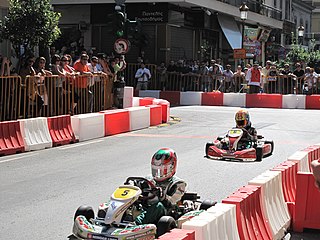
A kart circuit is a race track designed for kart racing or other forms of short-length motor racing, such as small-scale motorcycle racing, pocketbike racing, or radio-controlled model racing. There are several types of kart circuit, depending on the type of use desired.

Sprint cars are high-powered open-wheel race cars, designed primarily for the purpose of running on short oval or circular dirt or paved tracks. Historically known simply as "big cars," distinguishing them from "midget cars," sprint car racing is popular primarily in the United States and Canada, as well as in Australia, New Zealand, and South Africa.
OK-Junior is a kart racing class for top drivers aged 11 to 15.
The Rotax Max 125 Engine is a two-stroke 125 cc (7.6 cu in) engine designed by Rotax, part of Bombardier Recreational Products (BRP), to provide cost-effective but high speed kart racing. Built in Austria, the engine is liquid cooled, equipped with a balance shaft, integrated water pump, electric starter and centrifugal clutch. Its combination of onboard electric starter and centrifugal clutch simplifies its operation. This concept is called TaG (Touch-and-go).
KF2, is a kart racing class for top drivers aged 14 and up.
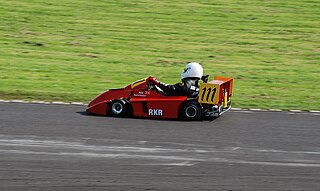
Superkart is a form of motorsport road racing that uses karts on long circuits. The bigger difference between a superkart and most other forms of kart is that they have full aerodynamic bodykits, as well as having a longer wheel base than sprint chassis, and are generally raced on car circuits over 1,500 metres in length. The power unit, most often but not exclusively two-stroke 250 cc engines, can be specially designed kart engines or production motorcycle engines with either five- or six-speed sequential manual gearboxes. Owing to their high top speed and superb cornering ability, a superkart's aerodynamic bodywork includes a front fairing, larger sidepods, and a rear wing. They use either 130-or-150-millimetre-diameter tires and wheels and most often race on full size auto-racing circuits.
A micro kart is a small, one passenger mini go-kart. These karts typically have two-stroke engines, ranging in size from 22.5 cc to 85 cc, and putting out anywhere from 1.2 hp to over 20 hp, or an electric motor with rechargeable lithium ion batteries.
The 2si 460 is a family of in-line twin-cylinder, two-stroke, single ignition, aircraft engines that were designed for ultralight aircraft.
The 2si 540 and 2si 500 are a family of in-line twin-cylinder, liquid-cooled, two-stroke, dual ignition, aircraft engines that were designed for ultralight aircraft.
Microstock is a form of full roll cage go cart or kart racing that originated in New Jersey invented by Bill and Bob Wagner.
KF1 is the top level of karting. It is open to drivers aged 15 and up.

An electric go-kart is a type of go-kart powered by electric motors and batteries or supercapacitors, as opposed to a traditional petrol engine.
The PRD Fireball is a two-stroke go-kart racing engine manufactured by Pro Racing Design Co, Ltd. Pro Racing Design is a Taipei, Taiwan based company, manufacturing an array of racing engines for use in professional go-kart racing worldwide. Pro Racing Design was founded by Chris Dell from Australia and it is now an Australian based manufacturer. The Fireball represents an engine targeted for multiple racing classes: International Kart Federation (IKF), World Karting Association (WKA) and Touch and Go (TAG) USA. The PRD Fireball is the cheapest TAG motor available to purchase new in the USA.
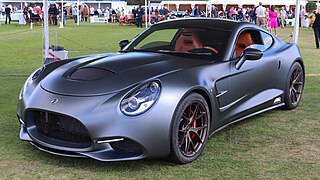
The Puritalia Berlinetta is a hybrid grand tourer manufactured by Italian automobile manufacturer Puritalia Automobili. Introduced at the 2019 Geneva Motor Show, it is the first car produced by the company. The car is intended to be a representation of the classic grand touring cars produced in the 1960s.
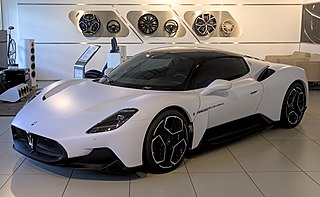
The Maserati MC20 is a two-seater, rear-mid-engine sports car produced by Italian car manufacturer Maserati.












